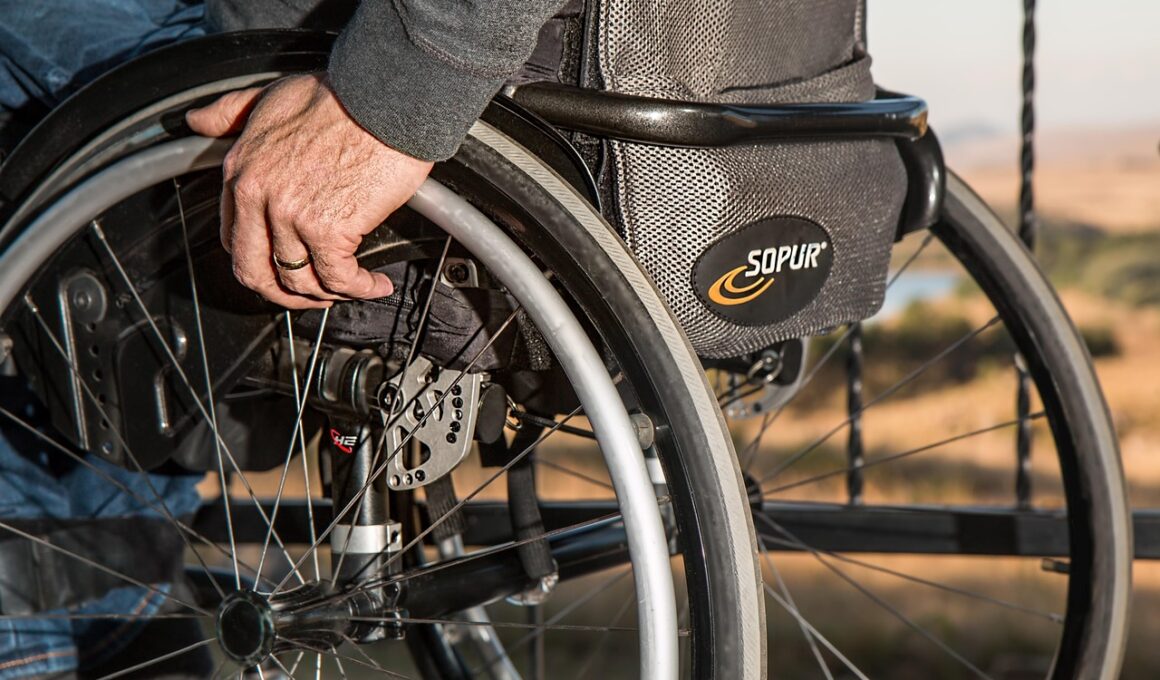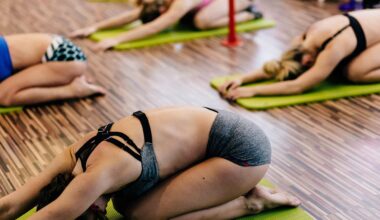The Science Behind Flexibility Adaptations for Various Disabilities
Flexibility and mobility are essential health components that directly impact an individual’s quality of life, particularly for those with disabilities. The limitations that people face can range from minor inconveniences to significant barriers in mobility. Adaptations to enhance flexibility often use various approaches, focusing on muscle and joint flexion. Assessments conducted by healthcare professionals can help determine specific needs for each person. Proper evaluation allows for targeted flexibility routines. These routines can include stretching exercises aimed at enhancing the range of motion. Tailored flexibility programs for individuals with disabilities must take account of physical limitations and existing medical conditions. Incorporating assistive devices, such as resistance bands, can also improve overall flexibility. Furthermore, tailoring exercises to fit individual abilities ensures participants feel empowered in their rehabilitation. The focus on flexibility can foster independence and improve mobility, leading to greater autonomy for daily living. Exploring specific adaptations for various conditions can also exhibit what works efficiently for specific disabilities ensuring that therapies applied offer optimal results in improving overall physical wellness.
Posture plays a crucial role in flexibility and mobility as well. Individuals with disabilities often have unique challenges, necessitating specialized posture adjustments. Incorrect posture leads to increased strain on muscles and joints, which may exacerbate rigidity. Adaptations emphasize maintaining proper alignment through various mechanisms, including ergonomic seating and standing systems. These systems help distribute weight evenly and reduce stress on the body, ultimately facilitating better movement. Through technology like adaptive chairs or standing frames, individuals are encouraged to engage in exercises without compromising comfort. Encouraging participation through group sessions can foster camaraderie and shared experiences that enhance motivation across diverse disability groups. Participants feel connected, leading to resilient support systems. Moreover, community resources play a vital role in providing access to facilities and equipment that aid flexibility skills effectively. The incorporation of exercise classes led by trained professionals addresses diverse population needs. Furthermore, they equip participants with techniques tailored to individual circumstances ensuring adaptation to unique abilities. Integrating community and professional support enables a holistic approach to enhancing flexibility and mobility, ultimately improving the lives of individuals with disabilities through targeted adaptations.
The Role of Technology in Flexibility Adaptations
Technology has significantly influenced adaptations for those with disabilities through increased flexibility and mobility opportunities. Devices such as range-of-motion measurement tools offer essential feedback for rehabilitation practitioners. These tools assist in monitoring improvements over time. Furthermore, virtual platforms enable remote consultations, allowing individuals to receive guidance tailored to their needs. Patients can better connect with specialists who understand their unique situations through teletherapy. Such access enhances the efficiency of creating personalized flexibility routines. Wearable technology, like smart fabric sensors or fitness trackers, collects data, providing insights on a participant’s activity level and mobility progress. Adaptations rooted in technological advancements provide participants with real-time feedback, encouraging commitment to their rehabilitation goals. Mobile applications specifically focus on physical therapy exercises that athletes and patients with disabilities can use. These apps often come with instructional videos and progress tracking capabilities. The emergence of such technology encourages users to participate actively in their recovery while facilitating communication between therapists and patients. Moreover, innovations in robotics also help create therapeutic instruments that enhance mobility and flexibility for diverse populations, ultimately reshaping rehabilitation practices.
Physical therapy remains an integral component of adaptations in enhancing flexibility and mobility. Therapists engage patients in personalized exercise routines aimed at improving muscle length and joint range of motion, considering individual capabilities and limitations. Techniques such as manual therapy can be utilized to alleviate muscle tightness, while aquatic therapy offers a unique environment for improving flexibility with reduced gravity effects. Physical therapies designed specifically for patients with disabilities must focus on functional outcomes that will help integrate activities of daily living (ADLs) into practice. For example, enhancing mobility through gait training aids individuals in recovering independence during ambulation. Functional training exercises can bridge the gap between rehabilitation and active involvement in daily routines. Support from family members can further increase commitment to therapy. Those close to the individual can encourage consistent adherence to prescribed routines. Setting realistic, measurable goals fosters a sense of achievement for each milestone reached as adaptations become evident. Furthermore, continued assessment ensures exercises suit evolving needs as progress is made while adapting to life changes. Therefore, physical therapy remains a supportive pillar for achieving optimal flexibility and mobility.
Inclusive Programs for Flexibility and Mobility
Incorporating inclusive programs designed expressly for individuals with disabilities is crucial for enhancing flexibility and mobility. Community fitness programs should aim to accommodate everyone, fostering access to adapted exercise classes and recreational activities. Established programs ensure an inclusive environment encouraging social interactions while promoting a sense of belonging. Engaging participants across various disability spectrums broadens individuals’ views on flexibility adaptations. By collaborating with local fitness instructors, these programs can create activities tailored to meet varying needs. Examples may include chair yoga, adaptive martial arts, or modified pilates that focus on stretching and strengthening skills while remaining accessible. Training individuals with disabilities in certain sports also enhances physical abilities while fostering teamwork. Sports programs that prioritize inclusivity can further empower individuals with disabilities to participate actively while cultivating self-confidence. Partnerships with local organizations can provide resources for equipment designed to support adaptive sports, ensuring comprehensive support. Liaising with local disability councils fosters promotion and helps increase awareness around adaptive programs, creating pathways for growth. Ultimately, inclusive programs are instrumental in driving personal development while nurturing community integration for those with disabilities.
Nutrition enhances overall physical health, playing a significant role in flexibility and mobility adaptations. Proper nutrition supports the body, allowing for improved muscle recovery and maintaining optimal energy levels throughout exercise routines. Nutritional deficiencies can hinder progress and increase susceptibility to injury. Adaptations must encourage proper dietary habits that complement fitness programs, ensuring individuals with disabilities receive essential nutrients. A balanced diet includes a variety of fruits, vegetables, lean proteins, and whole grains designed to boost energy and promote health. Introducing educational workshops focused on nutrition can empower individuals by equipping them with knowledge about dietary needs. Collaborations with dietitians offer personalized meal plans addressing specific health concerns related to mobility and flexibility. Integrating nutrition discussions into rehabilitation programs helps connect dietary needs with physical goals imploring a holistic approach to recovery. Moreover, sharing recipes and cooking tips fosters community, allowing participants to share experiences. Overall, when combined with flexibility adaptations, nutrition can bolster efforts in enhancing mobility outcomes. Encouraging participants to explore new foods and develop healthy eating habits ultimately supports their overall well-being and quality of life.
Future Directions in Flexibility Adaptations
The future of flexibility adaptations for disabilities continues to evolve rapidly, influenced by developing research and technology. Advancements, especially in genetic research, are expected to unveil new insights into how disabilities impact flexibility. Understanding individual physiological responses will enhance customized treatment plans leading to significant improvements in mobility. Engineers and healthcare professionals are increasingly collaborating to develop innovative adaptive equipment designed to support dynamic movement. Customizable devices can enhance navigability based on personal preferences, improving overall adaptability. Furthermore, research on neuroplasticity highlights the potential for altering motor functions through consistent practice, providing opportunities for individuals to enhance flexibility actively. The introduction of supportive social environments encouraging active participation can drive self-confidence for individuals undergoing adaptations. Ongoing training approaches will encourage adaptive physical therapies emphasizing inclusivity. By nurturing a proactive approach to flexibility adaptations, the potential for overcoming barriers will increase. Consequently, opportunities for community involvement will flourish as advocacy strategies emerge promoting awareness of comprehensive solutions for individuals with disabilities. Overall, these future directions pave the way for enhanced flexibility adaptations that redefine mobility experiences for all.
This article outlines essential considerations for enhancing flexibility and mobility among individuals with disabilities. Through a nuanced understanding of adaptations diverging into specialized programs, techniques, and innovations, significant strides can be made. Tailoring flexibility approaches caters to personalized needs while ensuring community inclusiveness. Therefore, emphasizing the dynamic interplay between physical therapy, nutrition, and technology fosters optimal quality of life. Overall, as we invest in this crucial area, we remain committed to empowering people with disabilities, helping them embrace their potentials while igniting change within the community.


